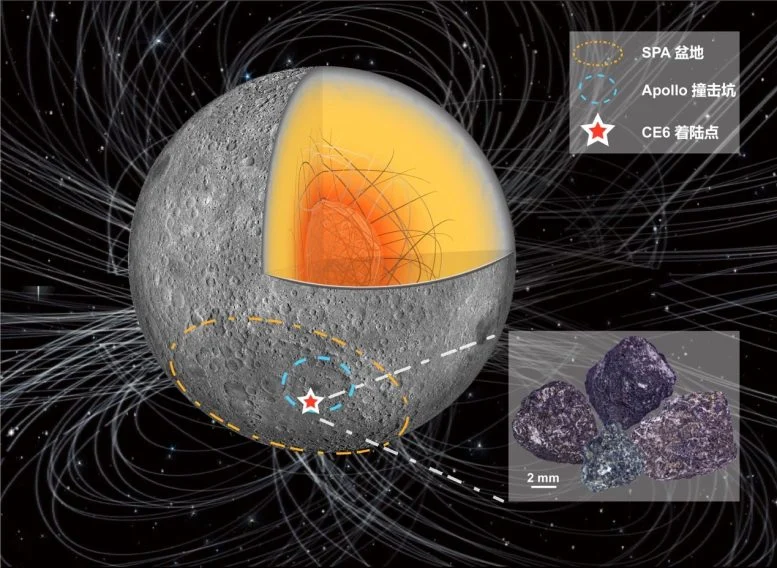
By Chinese Academy of Sciences December 24, 2024
Collected at: https://scitechdaily.com/change-6-moon-mission-uncovers-secret-hidden-for-billions-of-years/
A study using Chang’e-6 farside basalts reveals an unexpected boost in the Moon’s magnetic field strength 2.8 billion years ago, challenging previous ideas of a dormant lunar dynamo.
The data suggests a dynamic and geologically active lunar interior, possibly driven by magma oceans or core processes.
Lunar Dynamo Evolution
Understanding the evolution of the lunar dynamo is key to unraveling the Moon’s deep interior structure, thermal history, and surface environment. Recent research by Chinese scientists, analyzing basalts brought back by the Chang’e-6 mission, uncovered a major resurgence in the lunar dynamo’s strength around 2.8 billion years ago (Ga).
This landmark study was published on December 19 in the journal Nature.
While earlier paleomagnetic studies of nearside lunar samples provided a general timeline for the Moon’s magnetic field evolution, the lack of comprehensive spatial and temporal data has made the full history of the lunar dynamo uncertain.
The Chang’e-6 Mission: A Farside Discovery
The Chang’e-6 mission, which returned the first farside basalt samples dated to approximately 2.8 Ga, provides a unique opportunity to fill this critical gap in our understanding of the lunar dynamo’s spatiotemporal evolution.
Led by Prof. Rixiang Zhu at the Institute of Geology and Geophysics of the Chinese Academy of Sciences (CAS), Associate Professor Shuhui Cai and her colleagues measured the ancient magnetic field strength from the Chang’e-6 basalts, obtaining values ranging from approximately 5 to 21 microteslas (µT).
Rethinking Lunar Dynamo Hypotheses
These findings revealed an unexpected resurgence in field strength at 2.8 Ga, following a sharp decline around 3.1 Ga. This challenges the prevailing hypothesis that the lunar dynamo entered a low-energy state after 3 Ga and remained in this condition until its cessation.
The researchers proposed that the lunar magnetic field during this period may have been driven by a basal magma ocean and/or powered by precessional forces. Additional mechanisms, such as core crystallization, may have also a role.
These findings suggest that the Moon’s deep interior remained hot and geologically active well into its mid-early history.
The First Farside Paleomagnetic Data
This study represents the first-ever paleomagnetic data obtained from the Moon’s farside, providing critical insights into the intermediate stages of the lunar dynamo’s evolution. By synthesizing this data with existing findings, the researchers suggested significant fluctuations in the lunar magnetic field between 3.5 and 2.8 Ga, indicating a highly unstable dynamo during this period.
Implications for Future Lunar Exploration
These results offer valuable guidance for future lunar exploration missions, including the search for potential magnetic reversals.
Reference: “A reinforced lunar dynamo recorded by Chang’e-6 farside basalt” by Shuhui Cai, Kaixian Qi, Saihong Yang, Jie Fang, Pingyuan Shi, Zhongshan Shen, Min Zhang, Huafeng Qin, Chi Zhang, Xiaoguang Li, Fangfang Chen, Yi Chen, Jinhua Li, Huaiyu He, Chenglong Deng, Chunlai Li, Yongxin Pan and Rixiang Zhu, 19 December 2024, Nature.
DOI: 10.1038/s41586-024-08526-2
The research was conducted in collaboration with the National Astronomical Observatories, CAS. Lunar samples were supplied by the China National Space Administration, and the study was supported by the National Natural Science Foundation of China, the Strategic Priority Research Program (Category B) of CAS, and the Key Research Program of the Institute of Geology and Geophysics, CAS.

Leave a Reply